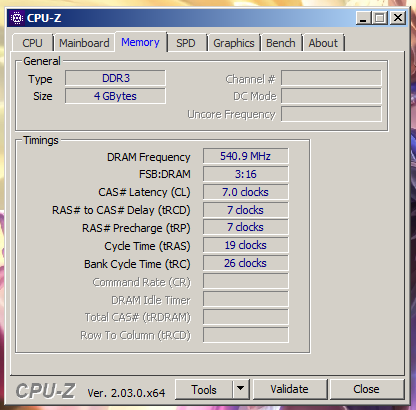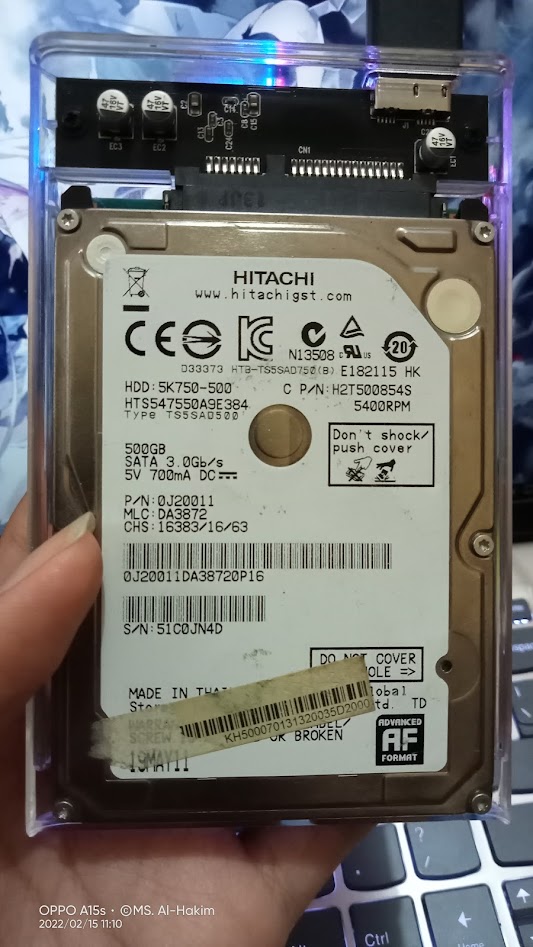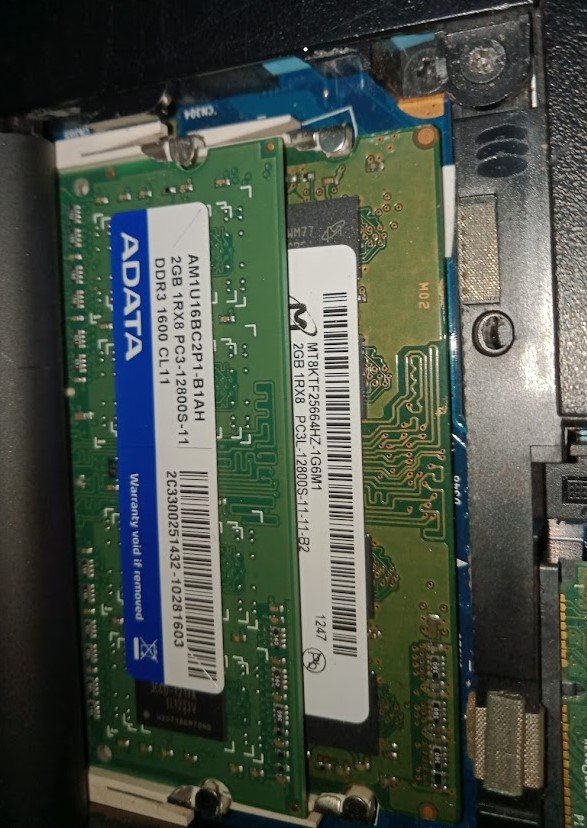Comparing: DDR3 SODIMM 1066MHz [Disk] vs Hitachi HTS547550A9E384
In this comparison, we analyze two Disks: DDR3 SODIMM 1066MHz [Disk] and Hitachi HTS547550A9E384, using synthetic benchmark tests to evaluate their overall performance. This side-by-side comparison helps users understand which hardware delivers better value, speed, and efficiency based on standardized testing. Whether you're building a new system or upgrading an existing one, this benchmark-driven evaluation offers valuable insights to guide your decision.

DDR3 SODIMM 1066MHz [Disk]
| Type: | Disks |
|---|---|
| Model: | DDR3 SODIMM 1066MHz [Disk] |
| Capacity: | 2GB |
| Interface: | DDR3 |

Hitachi HTS547550A9E384
| Type: | Disks |
|---|---|
| Model: | Hitachi HTS547550A9E384 |
| Capacity: | 500GB |
| Interface: | SATA-II 3Gbps |
Specification Comparison Table
This specification comparison presents technical details of several devices or components to help you understand the key differences between each option. Use this table as a reference to determine which device best suits your needs.
| Specification | DDR3 SODIMM 1066MHz [Disk] | Hitachi HTS547550A9E384 |
|---|---|---|
| Brand | - | Hitachi |
| Format | RAM Disk | HDD 2.5 |
| Capacity | 2GB | 500GB |
| Interface | DDR3 | SATA-II 3Gbps |
Submission Comparison Table
This submission comparison table displays the number and details of benchmark data submissions from various devices or components. This information helps you understand the performance based on the benchmarks that have been tested, as well as providing an overview of the consistency and popularity of the available benchmark results.
| No. | Benchmark Software | DDR3 SODIMM 1066MHz [Disk] | Hitachi HTS547550A9E384 |
|---|---|---|---|
| 1 | CrystalDiskMark |
Read: 746.24 MB/s Write: 828.18 MB/s |
Read: 88.66 MB/s Write: 88.06 MB/s |
Submission Comparison Chart
This chart visualizes the benchmark scores comparison between two hardware devices based on submitted data.
Media Gallery
A collection of photos of tested hardware. These images can help you identify the physical form, model, and variant of the hardware in question. These photos are from our own documentation, and if they are not available we may not be able to document them.
About Hardware DDR3 SODIMM 1066MHz [Disk]
DDR3 SODIMM 1066MHz is a third-generation memory module with a speed of 1066MHz that is commonly used in laptops and small devices. With the SODIMM form factor, these modules are often the standard choice for mobile computing systems, serving as the main memory for running operating systems, applications, and light to medium multitasking processes.
However, in this particular experiment, two 1066MHz DDR3 SODIMM modules from Micron and ADATA (2GB capacity each) were uniquely configured as a RAMDisk, a temporary storage space that uses RAM capacity to simulate a storage drive with much higher access speeds than SSDs or HDDs.
The 1066MHz DDR3 SODIMM-based RAMDisk test was conducted on an HP 1000 1b05au laptop device, powered by an AMD E1-1200 processor. The system is equipped with a 2x2GB DDR3 SODIMM 1600MHz RAM configuration, but due to processor architecture limitations, the memory only runs in single channel mode with an effective speed of 1066MHz. The operating system used is Windows 7, and to create and manage the RAMDisk, two popular applications, SoftPerfect RAMDisk and ImDisk Virtual Disk Driver, were used. The configured RAMDisk size was 2GB, utilizing some of the available RAM capacity.
Even though the device specifications are old and have limited memory bandwidth, the RAMDisk configured in this system was still able to show excellent performance in the read and write speed benchmarks. Based on tests using CrystalDiskMark, the read speed reached 746.24 MB/s, while the write speed touched 828.18 MB/s. In a follow-up test using ATTO Disk Benchmark with a 64MB block size, the read speed increased to 1020.00 MB/s, and the write speed reached 1080.00 MB/s. These results prove that even on older systems, RAMDisk configurations are still capable of delivering very high I/O performance, far surpassing conventional storage such as HDDs or even some SSDs.
Analysis
The results show that a 1066MHz DDR3-based RAMDisk is still capable of delivering data transfer speeds on par with entry-level NVMe SSDs, even outperforming many SATA SSDs and leaving conventional HDDs far behind. This makes RAMDisks an ideal solution for temporary use such as:
- Application caching,
- Temporary file storage,
- Fast computing with high I/O,
- Software or script testing without the risk of contaminating the main file system.
Although limited to a small capacity (2GB in this test), RAMDisk is still very useful for specific needs, especially for users with more than enough RAM or older devices that want to maximize their performance.
Test on:
Device: HP 1000 1b05au
Specs:
CPU: AMD E1-1200
OS: Windows 7
RAM: 2x2GB Single Channel 2 DIMM 1066MHz (Does not support dual channel due to limitations of the CPU, currently running single channel mode and 1066MHz)
Wednesday, 26 December 2012 14:27:32 | Update: 1 month ago
About Hardware Hitachi HTS547550A9E384
The Hitachi HTS547550A9E384 is a 500GB 2.5-inch hard disk drive (HDD) designed for laptops, notebooks and portable devices. This HDD belongs to the Travelstar 5K750 line, which is known for its balance between performance, power efficiency and reliability.
Using a 3.0Gbps SATA-II interface and a rotation speed of 5400 RPM, the drive offers good enough performance for daily computing activities such as document storage, multimedia playback, and light operating system installation. Equipped with an 8MB buffer cache, this hard drive provides a stable usage experience, though not as fast as a 7200 RPM HDD.
The Hitachi HTS547550A9E384 comes with a 500GB capacity, enough to store thousands of documents, photos, and multimedia files on a single device. This hard disk uses a 2.5-inch form factor with a SATA-II (3.0Gbps) interface, which is still widely used in older generation laptops. The spinning speed is 5400 RPM, which is not as fast as a 7200 RPM HDD, but it is more power-efficient and quieter in operation.
Underneath the body, this HDD has an 8MB buffer (cache), and consists of two platters and three data-reading heads. The drive is part of the Travelstar 5K750 line, which is known for its durability and efficiency for everyday use, especially in portable devices or laptops with limited power.
To determine its performance, the drive was tested using an HP 1000 1b05au laptop powered by an AMD E1-1200 processor, with a 2x2GB DDR3 1066MHz RAM configuration in single channel mode due to limited dual channel support on the CPU. The drive is mounted via HDD Caddy on the DVD slot and runs Windows 7 operating system.
In tests using CrystalDiskMark, the HDD recorded a read speed of 88.66 MB/s and a write speed of 88.06 MB/s. These results reflect the typical performance of a 5400 RPM HDD with a SATA-II interface, sufficient for standard use such as light booting, file storage, and basic applications.
That's consistent performance with 5400RPM HDDs of this generation and interface. While these drives don't rival SSDs in terms of speed, they are still an ideal power-saving storage solution for devices with battery limitations or legacy devices that still rely on mechanical storage.
Device test (testbed):
Device: HP 1000 1b05au (using HDD Caddy on DVD Slot)
Specs:
CPU: AMD E1-1200
OS: Windows 7
RAM: 2x2GB Single Channel 2 DIMM 1066MHz (Does not support dual channel due to limitations of the CPU, currently running single channel mode and 1066MHz)
Friday, 05 November 2021 02:24:43 | Update: 1 month ago



